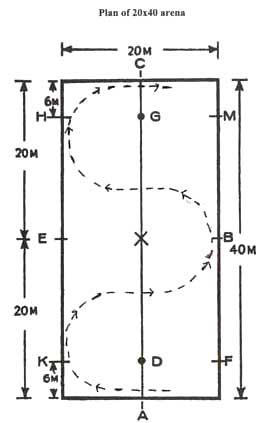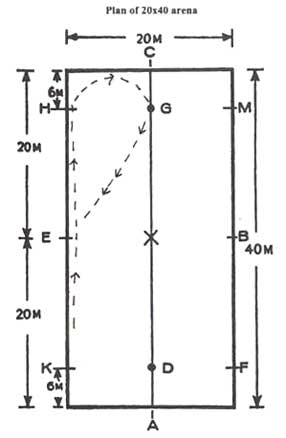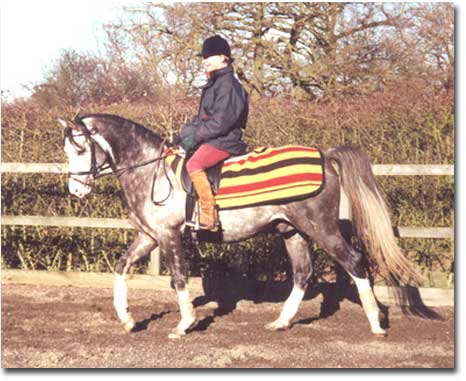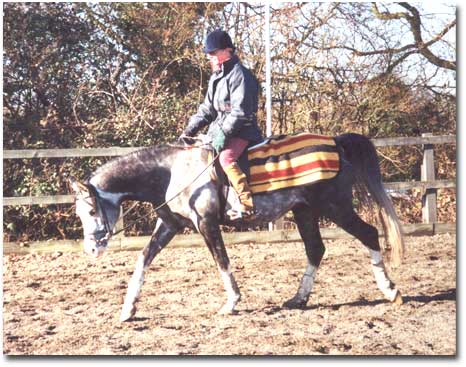When I teach a new pupil , before any riding is done, we have a discussion
on various basic issues of horsemanship. Position is crucial as the distribution
of your bodyweight will dictate much of your horses way of going, so work
hard on getting your position right and show as little movement as possible.
The most valuable tip I can give you on this is to ride without stirrups on
a regular basis ( though not on a youngster, and always warming up the horse
through the back before removing your stirrups ). If you do this you will find
your balance ,position and effectiveness is greatly improved.
The next point to discuss is 'accuracy .If you adopt the habit of riding accurately
from day one you will always pick up marks in a dressage test.When you school
your horse always plan exactly what you're going to do and always insist that
your horse goes exactly where you want him to go.
At Preliminary level you will find you have some leeway in certain tests as
to the exact point that you make a transition e.g. in Prelim 7 you can make
a canter transition at any point on the circle between X and A .Choose these
easier tests at first until you can be confident of making a transition at
the exact point stated.
When you practice at home it's wiser not to practice the whole test
too many times as this will make your horse anticipate. Practice riding
parts of the
test and make sure you understand the exact size and shape of the patterns
yo will be riding. My first riding instructor, the late Lionel Graham,
taught me a wonderful way to memorize tests. He told me to draw a picture
of each
movement in the test .I would roughly draw the required amount of mini
arenas and fill in the movements with dotted lines. By the time I'd
laboriously done
this I could picture the whole test clearly in my head. Of course,as
you ride, more and more tests you automatically start to memorize
them quickly.

1 A three loop serpentine
starting from letter A
At
Prelim level you will ride 5 metre loops, serpentines,
20 metre circles , half ten metre circles and changes
of the rein through X'.
You may perform
your test in sitting or rising trot but don't forget to sit on the
correct diagonal in rising trot (always sitting when the outside
shoulder comes back
) . This is another habit best learned from day one as you will encourage
your horse to become one sided and unbalanced if you are not strict
on this.

2
A half ten metre circle between H and G returning to
the track at letter E
When
riding serpentines change the diagonal when crossing
the centre line. When riding a loop change diagonal
at the widest point of the
loop and again
when reaching the track . When changing the rein through letter
X this is where you change the diagonal.. When
changing the rein aim
just before the
marker, this will ensure that as you hit the track and straighten
up you will be spot on.
When you feel ready to make your first attempt at a test it's most
important that you think positively and ride positively , always
remember the 'F' word
, .FORWARD . Ride your horse forward in all paces and through all
transitions , it's just as important to ride forward in the downward
transition as in the
upward. Forward does not mean faster, it means creating more energy,
power and impulsion. This needs to come from behind the saddle
as this
is where the horses
engine is and it will mean the difference between obtaining good
marks or adverse comments such as 'not in front of the leg'.

Czak demonstrates his medium walk.
In
most tests the best mark can be picked up from
the walk work as one of these marks will usually
be doubled.
In your free walk on a long rein the horse should
be stretching down and out and seeking the contact of the bit .
The reins should
be long but not loose or baggy. He should be 'marching' , as if
walking toward a bucket of oats. If you allow your
horse to
dawdle in the walk he may not even
track up,get a friend to watch you from the ground and tell you
when you are obtaining a good 'overtrack'. This means
that the hind feet should be falling
ahead of the tracks made by the front feet and this is what you
want.

Note the difference as Czak now performs his 'free walk on a long rein'.
It
may be a good idea , the first time you compete,
if you get a friend to call the test for
you then you can concentrate solely on
what you are doing.
Don't make the mistake of going out and performing just one
test ,if you can help it.It's essential, if you and
your horse are
inexperienced, that if things
go badly in the first test you then have an opportunity to
go in again and put things right. My experience
with novices is that things
are much less tense
the second time in.
lf you are nervous it's quite easy to make an 'error of course'
and go wrong. It's only one movement so it needn't affect the
whole too seriously. If I make
an error of course I use this little hiatus of time to collect
my thoughts, my horse and my wits! I then turn it to my advantage
by
preparing carefully
for the correct movement. You only lose 2 marks for your first
error but things can become costly if you make more than one
mistake and
2 marks can easily
cost you first place if you're unlucky ( as I know to my cost
).
Finally we come to the turnout of you and your horse.In this
aspect dressage is similar to showing.You should look your
best in order
to create a good overall
impression. This combined with a good entry and a straight
centre line will set your stock soaring with the judge.
At the lower levels of dressage it's correct to wear a tweed
jacket together with a neatly tied stock (practice makes perfect
), beige
or cream breeches
or jodhpurs, a
velvet hunting cap or crash cap and long boots or jodhpur boots
(in the case of a junior).It's also acceptable to wear a collar
and tie. It
is compulsory
to wear gloves. You may carry a schooling whip and you may
wear spurs .Chin straps are compulsory at most unaffiliated
venues
but not at
affiliated ones. It is
not permitted to carry a
whip in championships.
Ideally your horse should be plaited , in the case of an Arab
or mountain and moorland pony a crest plait is desirable (
again, practice
makes perfect ).
A snaffle bridle should be worn and although there are several
types of snaffle bit you can only use one where the mouthpiece
is made
of the same substance, i.e.. no copper link in a stainless
steel bit etc. Martingales and bit guards are not permitted,
even in the warm up, and
boots must
be removed before entering
the arena.
If you possess a dressage saddle obviously this is the best
type of saddle for you to wear as it will help you. If not
a straight
cut saddle ( show or
working hunter ) or a GP will be suitable in brown or black
. For a numnah I think a simple white dressage square looks
nice.
Well, you're all set to go! As the judge rings the bell, or
beeps the horn (this means you have one minute to enter ),
think positive!
You owe this to
your horse because however hard your heart is beating or however
powerless your legs have become, your horse needs you.
So,
go ahead, ride him and good
luck !
Kit Rolfe
If
anyone would like to discuss placing a horse with
Kit for schooling , dressage / showing production
or breaking
please e-mail kitrolfe@songbirdarabians1.wannadoo.co.uk or Tel 01787 472053 (North Essex )